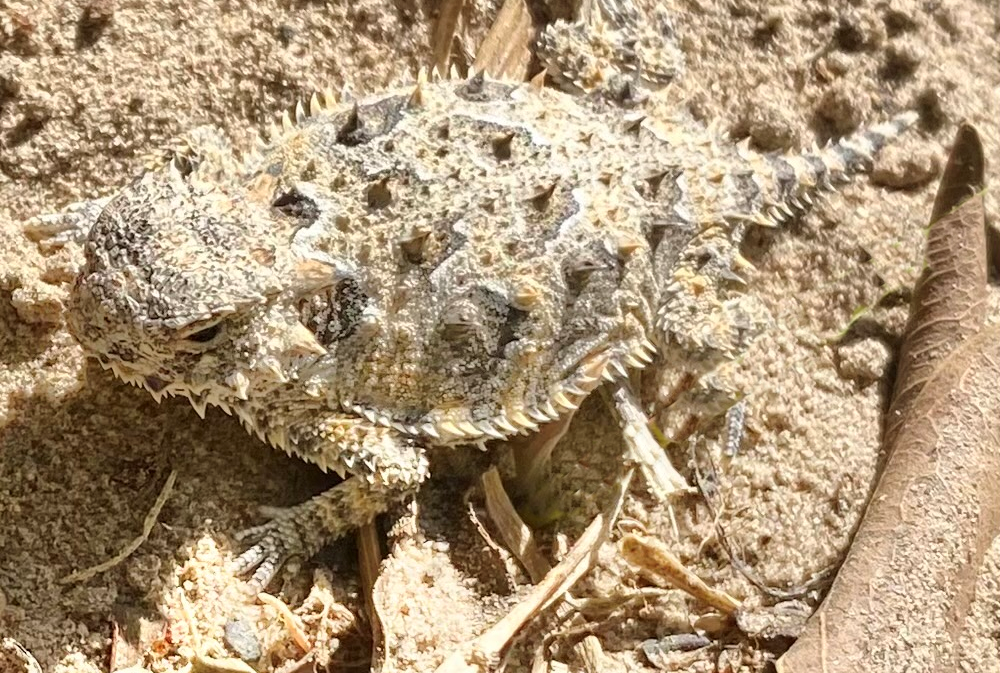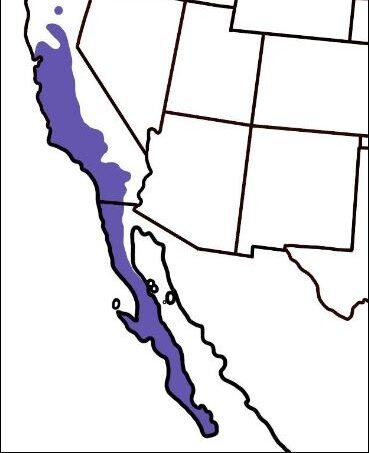Coast Horned Lizard, Phrynosoma coronatum

 Coast Horned Lizard, Juvenile, Phrynosoma coronatum. Lizard found within a residential community within the greater Puerto Adolfo Lopez Mateos area, Baja California Sur, January 2024. Body Length: 5.5 cm (2.0 inches). Photograph and identification courtesy of Brad Murakami, Surrey, British Columbia, Canada.
Coast Horned Lizard, Juvenile, Phrynosoma coronatum. Lizard found within a residential community within the greater Puerto Adolfo Lopez Mateos area, Baja California Sur, January 2024. Body Length: 5.5 cm (2.0 inches). Photograph and identification courtesy of Brad Murakami, Surrey, British Columbia, Canada.
The Coast Horned Lizard, Phrynsoma coronatum, is a member of the Phrynosomatidae family of North American Spiny Lizards, which include the Zebra-Tailed, Earless, Fringe-Toed, Spiny, Tree, Side-Blotched and Horned Lizards. The Phrynsomatidae family consists of one hundred-twenty members placed in nine genera. There are twenty-two species in the Phrynosoma genus. They are also known as the Cape Horned Lizard and in Mexico as Lagartija-cornuda de Litoral.
Coast Horned Lizards have a flat, wide body and a short tail. Four to five temporal spines line each side of their head. On the posterior side of their head, two long occipital horns point up and back. They have two rows of fringe scales on their sides at the margin of their abdomen and dorsum. Their coloration resembles their environment, and their dorsum is typically tan or gray with dark spots and spiny scales. A continuous white stripe bordered by black marks their dorsum along their spine. Their ventral surface is lighter in color. Dark lines radiate from their eye to upper lip, and over their head. Sexual dimorphism is displayed with the females growing larger than the males. Females and males measure 13.0 cm (5.1 inches) and 9.4 cm (3.7 inches) in snout to vent length, respectively. Additionally, females possess noticeably enlarged postanal scales. During the breeding season, males have a wider tail base and prominent femoral pores.
Coast Horned Lizards are primarily diurnal and their activity is dependent upon the environmental temperature. In the mornings and evenings, they can be found on open ground where they bask and hunt for insects. During the hot afternoon sun, they take shelter under rocks, in rodent burrows, under woody vegetation, or in crevasses to avoid predation. They hibernate from October until late March by burying themselves under soil, litterfall, and foliage. Their burrows have an average depth of 140 mm (5.5 in) and tend to face south or southwest, where sunlight exposure is highest during the winter. Coast Horned Lizards begin breeding immediately after hibernation from mid-April through mid-June. To express interest in a female, the male performs a display of quickly bobbing his head up and down. If the female is not satisfied, she may reject the male by waving her tail or simply moving away. If the mating attempt is successful, the pair will engage in a form of amplexus with the male atop the female. After mating, the female rejects all other attempts at courtship and the male shows no further interest in the female. Gestation lasts for fourty-four days, before a single clutch of thirteen to fifty (average of twenty-five) eggs are laid from late May to early August. During favorable years, individual females may produce multiple clutches. Females lay their eggs in a tunnel that they dig in loose soil. After laying their eggs, females refill the tunnel using their forelimbs and head. Finally, they scatter the soil around the tunnel to hide evidence of their nesting site. This whole process may take an individual five to ten hours to complete. Females stay near the nesting site for a few hours after finishing their work before leaving their eggs to incubate for forty to sixty days. No additional parental care is provided. The young are precocial and become independent immediately upon hatching. Hatchlings are less spiny and have a snout to vent length of approximately 1.9 cm (0.8 inch) to 33 cm (1.3 inches). Both males and females reach sexual maturity two years after hatching. The lifespan of the Coast Horned Lizard in the wild is unknown; in captivity they have life spans of seven years.
Coast Horned Lizards are commonly observed foraging at or near ant nests, and most are found on roadways. Approximately two-thirds of their diet consists of Ants, particularly Harvester Ants, Pogonomyrmex rugosus. To catch their prey, Coast Horned Lizards tilt their heads sideways and lap the ants up into their mouths with their sticky tongues. If the opportunity arises, they will consume other insects and insect larvae. In turn, they are preyed upon by Coyotes, Western Diamond-backed Rattlesnakes, Sonoran Whipsnakes, Prairie Falcons, American Kestrels, Loggerhead Shrikes, Hawks, and Greater Roadrunners. Coast Horned Lizards have several defense mechanisms against predation. They flee from ambush predators and stand their ground against chasing predators. When standing their ground, they remain motionless until the predator passes by. If noticed, they may assume a defensive posture by flattening their torso, lowering their tail, and facing the threat with their mouth agape. If the threat approaches, they will hiss and lunge to defend themselves. Additionally, Cape Horned Lizards have the ability to squirt blood from the orbital sinuses around their eyes when threatened.
The Coast Horned Lizard occurs throughout most of west-central and southwestern California, as well as most of Baja California and Baja California Sur. Their elevational range extends from near sea level to approximately 2,438 m (8,000 ft). They occupy a variety of habitats including scrubland, grassland, coniferous woods, and broadleaf woodlands. They are typically found in areas with sandy soil, scattered shrubs, and ant colonies. The Coast Horned Lizard can be distinguished by all other horned Lizard species within their range by their light, mid-dorsal stripe bordered by black and dark lines radiating from their eyes to their lip, and over their head. From a conservation perspective, the Coast Horned Lizard is currently considered to be of Least Concern due to their wide distribution, tolerance of a broad range of habitats, and presumed large population size. The Coast Horned Lizard is now absent from much of its former southern Californian range due to urbanization, agricultural development, and over-collecting. In some areas, the non-native Argentine Ant, Linepithema humile, is displacing the native ant species upon which the Coast Horned Lizard feeds. In Baja California, the expansion of intensive agriculture is a threat, particularly in the Vizcaíno Desert, the Magdalena Plain, and the Isthmus of La Paz.